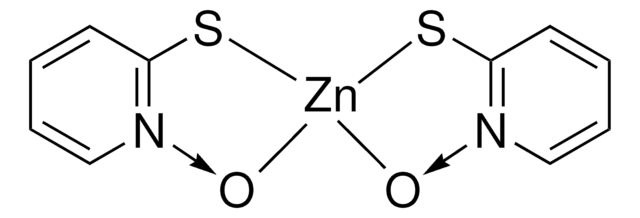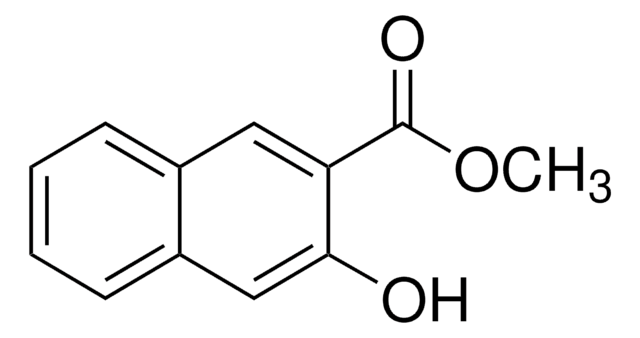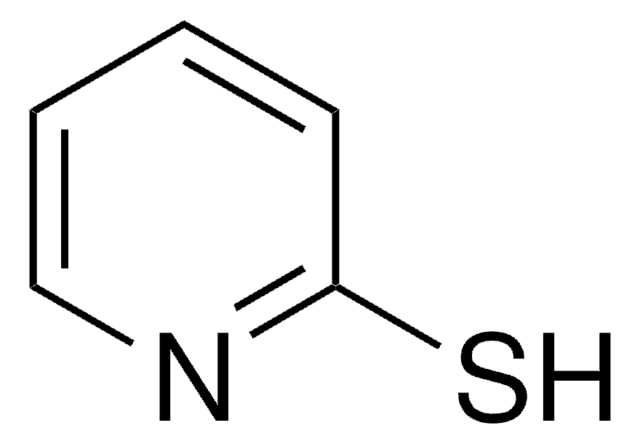188549
2-Mercaptopyridine N-oxide
99%
Synonym(s):
2-Pyridinethiol-1-oxide, Pyrithione
Sign Into View Organizational & Contract Pricing
All Photos(2)
About This Item
Empirical Formula (Hill Notation):
C5H5NOS
CAS Number:
Molecular Weight:
127.16
Beilstein:
109936
EC Number:
MDL number:
UNSPSC Code:
12352100
PubChem Substance ID:
NACRES:
NA.22
Recommended Products
Assay
99%
mp
69-72 °C (lit.)
SMILES string
[O-][n+]1ccccc1S
InChI
1S/C5H5NOS/c7-6-4-2-1-3-5(6)8/h1-4,8H
InChI key
FGVVTMRZYROCTH-UHFFFAOYSA-N
General description
2-Mercaptopyridine N-oxide forms complexes on reaction with palladium chloride. It inhibits NADH-fumarate reductase purified from Trypanosoma cruzi. It is precursor to O-acyl thiohydroxamates. It ligates to metals to form biologically active complexes.
Application
2-Mercaptopyridine N-oxide was used to investigate the mechanism of photodegradation of mercaptopyridine-N-oxide biocides. It was used in ratiometric fluorescence imaging of intracellular zinc ions in mammalian cultures.
Precursor to O-acyl thiohydroxamates. Ligates to metals to form biologically active complexes.
Signal Word
Danger
Hazard Statements
Precautionary Statements
Hazard Classifications
Acute Tox. 3 Oral - Eye Irrit. 2 - Skin Irrit. 2 - STOT SE 3
Target Organs
Respiratory system
Storage Class Code
6.1C - Combustible acute toxic Cat.3 / toxic compounds or compounds which causing chronic effects
WGK
WGK 3
Flash Point(F)
Not applicable
Flash Point(C)
Not applicable
Personal Protective Equipment
dust mask type N95 (US), Eyeshields, Gloves
Choose from one of the most recent versions:
Already Own This Product?
Find documentation for the products that you have recently purchased in the Document Library.
Photodegradation of mercaptopyridine-N-oxide biocides.
R A Neihof et al.
Archives of environmental contamination and toxicology, 8(3), 355-368 (1979-01-01)
J. Chem. Res. Synop., 30-30 (1990)
Christopher J Chang et al.
Proceedings of the National Academy of Sciences of the United States of America, 101(5), 1129-1134 (2004-01-22)
Zinc is an essential metal ion for human growth and development, the disruption of cellular Zn(2+) homeostasis being implicated in several major disorders including Alzheimer's disease, diabetes, and cancer. The molecular mechanisms of Zn(2+) physiology and pathology are insufficiently understood
Vesna Lavtizar et al.
Ecotoxicology and environmental safety, 147, 132-138 (2017-08-26)
Copper pyrithione (CuPT) is a biocide, used worldwide to prevent biofouling on submerged surfaces. In aquatic environments it rapidly degrades, however, one of the degradation products (HPT) is known to react with cupric ion back to its parent compound. Not
J F Turrens et al.
FEMS microbiology letters, 175(2), 217-221 (1999-07-01)
The enzyme NADH-fumarate reductase is not found in mammalian cells but it is present in several parasitic protozoa including Trypanosoma cruzi, the parasite that causes Chagas' disease. This study shows that the drug 2-mercaptopyridine-N-oxide (MPNO) inhibits NADH-fumarate reductase purified from
Our team of scientists has experience in all areas of research including Life Science, Material Science, Chemical Synthesis, Chromatography, Analytical and many others.
Contact Technical Service







